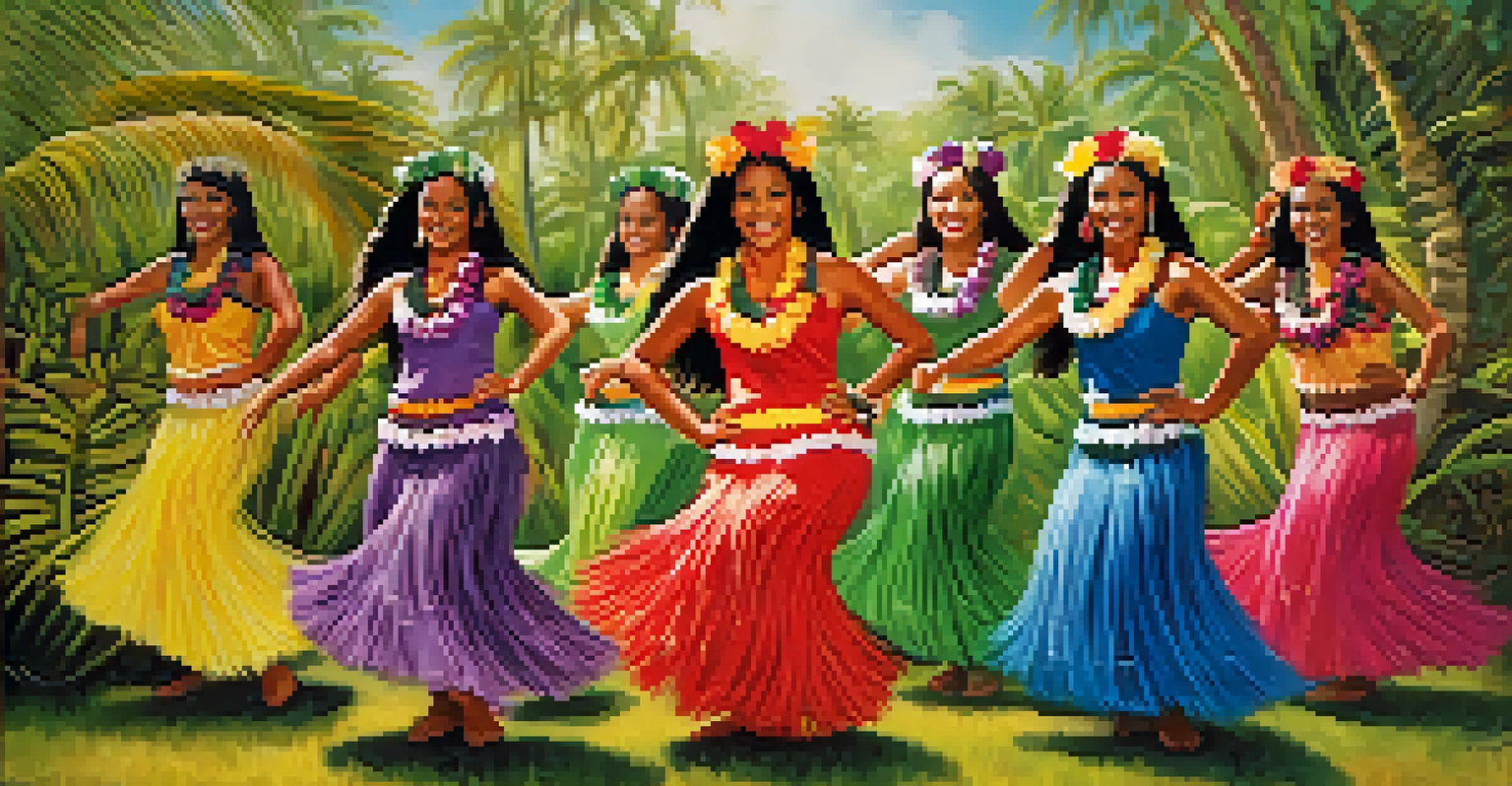Hawaii's Monarchy: The Rise and Fall of the Hawaiian Kingdom

The Origins of the Hawaiian Kingdom: A Brief Overview
The Hawaiian Kingdom traces its roots back to the late 18th century, when King Kamehameha I united the islands. This unification was no small feat, as it involved strategic warfare and alliances with local chiefs. Kamehameha's vision laid the groundwork for a centralized monarchy, establishing a sense of identity among the diverse Hawaiian people.
A nation’s greatness is measured by how it treats its weakest members.
Under Kamehameha's rule, the kingdom flourished. He implemented laws that enhanced trade and agriculture, transforming Hawaii into a thriving hub of commerce. The introduction of new crops and livestock also enriched the local economy, attracting foreign traders and visitors who brought their own cultures and ideas.
This period marked the beginning of a complex interaction between native Hawaiian traditions and foreign influences, which would shape the kingdom's future. As Hawaii became more connected to the global economy, the seeds of change were sown, setting the stage for both growth and challenges ahead.
The Golden Age: Cultural Flourishing Under Kamehameha's Successors
Following Kamehameha I, his heirs continued to expand and develop the Hawaiian Kingdom. Notably, King Kamehameha III, who ruled from 1825 to 1854, was instrumental in modernizing the kingdom. He introduced significant reforms, including a constitution that established a more democratic government, which was a remarkable step for its time.

This era also witnessed a renaissance of Hawaiian culture, as traditional arts, music, and hula began to thrive again. Schools were established, and literacy rates soared, allowing more Hawaiians to engage with both their heritage and new ideas brought by missionaries and explorers.
Kamehameha I Unified the Islands
King Kamehameha I's unification of the Hawaiian Islands in the late 18th century established a centralized monarchy and a unique cultural identity.
However, while the kingdom experienced cultural growth, the increasing presence of foreign powers began to loom over Hawaii. The balance between preserving traditional ways and adapting to outside influences became a delicate dance, foreshadowing conflicts ahead.
The Impact of Foreign Influence: Missionaries and Trade
The arrival of American missionaries in the early 19th century significantly altered the social landscape of Hawaii. They aimed to convert the Hawaiian people to Christianity and often imposed their values and beliefs. While their intentions may have been noble, the missionaries' influence extended into politics and education, paving the way for Western ideologies.
The past cannot be changed. The future is yet in your power.
Additionally, the burgeoning sugar trade attracted more foreign settlers, leading to economic changes that favored plantations and foreign investments. The sugar industry became a major economic driver, but it also increased the dependency of the Hawaiian Kingdom on foreign markets and labor.
As these changes took root, tensions grew between the native population and foreign settlers. The struggle for power and control over resources ultimately set the stage for escalating conflicts that would challenge the sovereignty of the Hawaiian Kingdom.
The Overthrow: A Pivotal Moment in Hawaiian History
The overthrow of Queen Liliʻuokalani in 1893 marked a tragic turning point for the Hawaiian Kingdom. After years of political maneuvering and growing discontent among American settlers, a group of businessmen and politicians staged a coup. With the support of U.S. military forces, they effectively removed the queen and established a provisional government.
This event was not only a loss for the monarchy but also a profound moment of cultural dislocation for many Hawaiians. Queen Liliʻuokalani, a strong advocate for her people's rights, fought valiantly to restore the monarchy, but her efforts were thwarted by the overwhelming influence of the United States.
Cultural Renaissance Under Monarchy
The successors of Kamehameha I, particularly King Kamehameha III, fostered a cultural renaissance that revitalized Hawaiian traditions and modernized governance.
The overthrow highlighted the complex dynamics of power, identity, and resistance within Hawaii. It left an indelible mark on the Hawaiian spirit, as many continued to advocate for sovereignty and recognition of their cultural heritage.
Annexation and Its Aftermath: Hawaii Becomes a U.S. Territory
Following the overthrow, Hawaii was quickly annexed by the United States in 1898, officially becoming a U.S. territory in 1900. This transition brought significant changes to the islands, as American policies influenced governance, economics, and social structures. While some welcomed the new opportunities, many Hawaiians felt a deep sense of loss and displacement.
The annexation sparked a cultural and political awakening among native Hawaiians. Movements advocating for Hawaiian rights and sovereignty began to emerge, as people sought to reclaim their identity and heritage. The struggle to maintain cultural practices and the Hawaiian language intensified during this period.
Despite the challenges, this era also laid the groundwork for a resilient Hawaiian identity that would continue to evolve. The fight for recognition and autonomy persists today, as many continue to honor their ancestors' legacies and advocate for their rights.
The Legacy of the Hawaiian Kingdom: A Lasting Influence
The legacy of the Hawaiian Kingdom is rich and multifaceted, shaping not only Hawaii's identity but also its place in global history. The kingdom's unique blend of culture, tradition, and resilience continues to inspire modern movements for sovereignty and cultural preservation. The stories of its leaders and the struggles of its people remind us of the importance of heritage.
Today, many Hawaiians actively work to revive and celebrate their culture, from traditional practices to language revitalization efforts. This resurgence is a testament to the strength and endurance of the Hawaiian spirit, showing that even in the face of adversity, cultural identity can thrive.
Struggle for Sovereignty Continues
The overthrow of Queen Liliʻuokalani and subsequent annexation by the U.S. ignited a lasting struggle for Hawaiian sovereignty and cultural preservation.
The history of Hawaii's monarchy serves as a powerful reminder of the impact of colonialism and the ongoing quest for self-determination. As we reflect on this past, it's crucial to honor the voices and experiences of those who came before us, ensuring their stories are not forgotten.
Contemporary Reflections: Hawaii's Search for Identity
In modern Hawaii, the legacy of the monarchy is felt in ongoing discussions about statehood, cultural preservation, and the rights of native Hawaiians. Many residents grapple with the complexities of their identity, balancing the influences of tourism and globalization with a desire to honor their roots. This dynamic often leads to vibrant conversations about what it means to be Hawaiian today.
Cultural events, festivals, and educational initiatives play a vital role in reconnecting people with their heritage. Efforts to teach the Hawaiian language and promote traditional practices are increasingly visible, fostering a sense of pride among younger generations. These initiatives help bridge the gap between history and modern life, allowing individuals to explore their identities deeply.

As Hawaii continues to evolve, the stories of its monarchy remind us of the importance of understanding our past. Embracing this history can pave the way for a more inclusive future, where all voices are heard, and cultural heritage is celebrated.